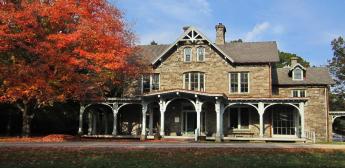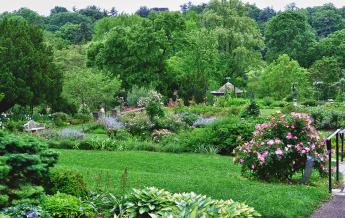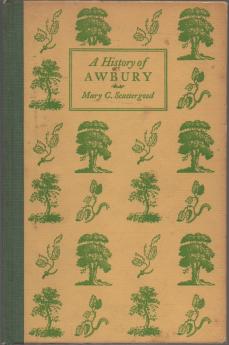Related Topics
Right Angle Club 2017
Dick Palmer and Bill Dorsey died this year. We will miss them.
Awbury

|
| Awbury Arboretum |
Philadelphia has many arboretums, because the early Quaker families had abundant land and their religion prevented them from spending money on portraits, theaters, and other forms of merriment. Awbury is an arboretum in Germantown, started by Quakers, but it has evolved into something quite different from the others. For one thing, it is older, since Awbury in England is very close to Stonehenge where the Druids are said to have worshipped astronomical phenomena. There are no stones in the area, and it has been learned fairly recently that if you strike the stones, they will chime. Such chiming stones are usually found at point of furtherest advance of glaciers, so these appear to have been moved. The residents from that area migrated with the Quakers a long time ago, although the Druids dominated the region a thousand years earlier. It's in Willtshire, if you plan to take a trip there, although you will be disappointed to learn that the early settlers were of no particular importance in England, while the Cope family which started the migration were early migrants, but not so early as to earn the right to belong to the Wellcome Society with William Penn.

|
| Arboretum |
The Copes originally settled in Delaware County, and had what is known as the arboretum on fifty acres in Germantown as a summer place. The location is in East Germantown, just north of what is now Roosevelt Boulevard, and would have been a pricey suburb when the Wissahickon creek housed the first industrial development in the region. The Quaker families intermarried and many of them settled near each other and the extensive mansions of the estate, which was originally purchased from William Penn for five shillings in 1681, and the summer homes were bought in 1853. The source of the obvious wealth is not recorded by Mary C. Scattergood, although it is mentioned that many ships were eventually owned by the Cope family. One surmises that prominent Quakers met at the various Quaker Schools, primarily Germantown Friends School, although there was a scholastic network of Quaker schools and colleges, including the many schools on Schoolhouse Lane, and Swarthmore, Haverford and Bryn Mawr Colleges. Large families were the rule in those days. The settlers at Awbury were both numerous and distinguished, quite evidently close-knit.

|
| (A History of Awbury ) |
The main history of Awbury was written by Mary C. Scattergood (A History of Awbury ), placing great emphasis on females and tending to skip over the male residents and their occupations. Women had children or became school teachers, and while the families obviously prospered, the main family occupations mostly must be discovered from other sources. Copes of various ancestry predominate, although the line began with the first immigrant Oliver Cope, who was a tailor. Mary Drinker Cope, and Ruth Anna Cope were early additions to the family, and Mary Drinker married John Haines to start a long line of Haines members. Apparently, Thomas was the originator of the many plantings, which eventually stretched to Stenton Avenue. It is mentioned that the Cope Packet Line (to China) of many ships dominated the Philadelphia harbor until steamships arrived in 1901. The Reading Railroad had a spur in the area, running from 9th and Green to Walnut Lane Station.
The various surnames to live in one house or another at Awbury (there are six of them) included Stokes, Emlen, Haines, Middleton, Evans, Dimick, Yarnell, Hazen, Stork, Lewis, Scattergood, Moore, Albertson, Foote, Kneedler, Aub, Hazard, McGill, Kimbers, Paramore.
Originally published: Sunday, April 16, 2017; most-recently modified: Tuesday, May 14, 2019